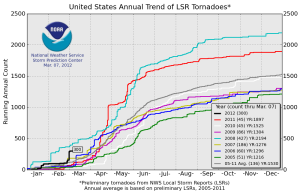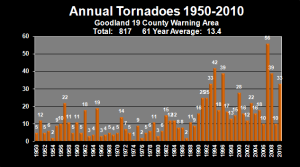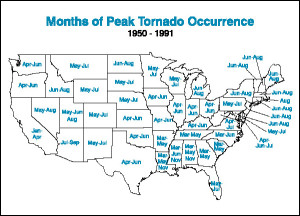We are only about two months into 2012, but already the United States has had 183 confirmed tornadoes and 49 associated fatalities as of March 7. With the debate about global warming and its consequences at the forefront of the nation’s attention, the public likely has many weather-related questions. What is to blame for the apparent increase in severe weather? Is the number of confirmed tornadoes this far into 2012 abnormal? Could global warming be causing an increase in tornadic activity?

Figure 1: Annual Running Total of Reported Tornadoes in the U.S. from 2005 through 2012. Image reproduced from SPC.
It is true that we have seen an unusually high number of tornadoes so far this year. In fact, since the Storm Prediction Center (SPC) in Norman, Oklahoma began charting the annual running total of U.S. tornadoes in 2005, only 2008 surpasses this year in total number of reported tornadoes through March 7 (see Figure 1). On a longer timescale, tornado reports have been increasing since 1950, with the greatest increase coming in the last two decades. Climate change advocates might be tempted to attribute this statistic to global warming, while skeptics could attribute this to pure chance.
The two biggest reasons for this rise over the past several decades, however, are not as contentious as it may initially seem – the increase is primarily due to population growth and improved communication technology.

Figure 2: Annual Number of Tornadoes Reported to the Goodland, Kansas NWS from 1950 to 2010. Image reproduced from NWS.
With more people living in broader areas across tornado-prone regions, fewer tornadoes have gone unnoticed, especially across the previously sparsely-populated Great Plains (see Figure 2). Additionally, as National Weather Service (NWS) offices and their outreach programs expanded in the 1990s, they had the ability to train more spotters and educate more individuals about how to report tornadoes. With the advent of the Internet, this process became even easier. Now, adding digital cameras, camcorders, and most recently smartphones into the mix has resulted in hardly a single tornado going unreported.
When a tornado is reported, however, it does not necessarily mean that a tornado actually occurred. While preliminary reports issued by the SPC include every tornado that was reported to each NWS office, often these reports will be from the same storm or from a non-trained spotter who mistook a microburst or strong gust front for a tornado. Only after trained meteorologists and engineers examine the damage site and classify it as tornadic does the tornado go from being ‘reported’ to ‘confirmed’. It is at this point that the tornado is given a damage rating on the Enhanced Fujita Scale, ranging from EF-0 (least damaging) to EF-5 (most damaging). Approximately 85% of reported tornadoes result in becoming confirmed tornadoes.
Population increase, better communication, and an unrepresentatively high initial number of reported tornados all factor in to this observed increase in tornadic activity over time. But where do the the contributions of these effects stop and the contribution of climate change begin when examining the increasing frequency and possibly strength of tornadoes?

Figure 3: Months of Peak Tornado Occurrence by State from 1950 to 1991. Image reproduced from the National Severe Storms Laboratory (NSSL).
With an observed increase in global surface temperature, it is not difficult to imagine that there would be more evaporation, more storm formation and precipitation, and thus more tornadoes. Unfortunately, this is a tough physical connection to make when trying to model changes in severe weather under a warmer climate. Tornadoes and severe storms are incredibly intricate, erratic, and short-lived events, and hence trying to ascertain their response (in frequency, intensity, and path) to global climate change has thus far been like throwing a rock into Niagara Falls and trying to see its splash. The response of tropical storm and hurricane activity under a warmer climate is slightly better understood since they are longer-lived and more predictable in the short-term, but the current questions still far outnumber the existing answers in this area as well.
The key point to take home is that while extreme weather events may seem to be becoming more prevalent and destructive every year, one must keep in mind every factor that influences our perception of such events. There is little doubt that a changing climate will result in changing frequency and strength of severe weather. But in order to properly understand and be prepared for how these events will continue to change in the future, we must be able to approach the science with as rational and unbiased a mindset as possible.
References

Comments are closed.